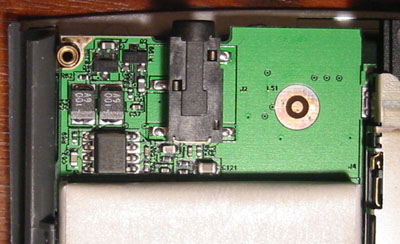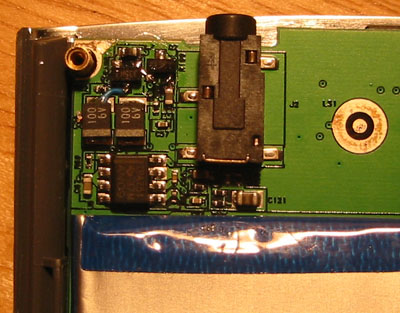I Actually Fixed a Piece of Consumer Electronics
At some point, my Palm Tungsten E started to develop problems. The “On” button started to feel a little mushy. I figured it was just the actual button device getting old. Which really shouldn’t happen after only a year, but what can you do. After some more use, I came to a time when I couldn’t turn on my Palm. So at that point I started to push harder on the button (because I am a big lug and that’s how I solve such problems.) Well, I eventually got the thing to turn on, but then the “On” button felt very mushy. That’s when I started to get nervous. And it turns out I had a reason to be.
At some point a few weeks later the thing wouldn’t turn itself Off. Which is a more serious problem, especially for a battery-powered device. Finally after all attempts to persuade it to turn off and stay off were unsuccessful, I determined that there was a serious problem.
Now of course it was out of warranty, because Palm doesn’t give you a very long warranty. And sending it back to Palm to be fixed cost only slightly less than buying a new Palm. ($125 to fix, $180 to buy a new Tungsten E) I don’t really have money to burn for either option, so I figured I’d have little to lose to try and fix it myself.
I opened it up and found that the “On” button device is very delicately soldered to the surface of the Printed Circuit Board inside. There’s no substantical anchoring, (such as a through-hole solder joint,) to secure this piece of mechanical electronics that will take abuse. (Ahem!) So basically what had happened was that the front two tiny contacts had come off from their surface-mount solder pads from my pushing on it. Well, no problem, soldering is what I do for a living. I soldered it back together.
But it still didn’t work. Hmmm. I turned it over and found that two 3-terminal surface-mount devices had been scraped off the circuit board, along with the traces that went with them. Ugh. How did that happen? Probably by me when I was trying to take the stupid thing apart. Luckily I found one of them. I knew the package shape was SOT-23, and that it had the digits “337” on it. Hmmm. Not much to go on. My epiphany came when I found this website. Apparently it’s a common problem: Surface Mount Devices (SMD) are so tiny, that only 3 digits will fit on their small surface area. Well if you go to the link above, you can type in those 3 digits and find out the few devices that are possible with that code. Then knowing the package type (in my case SOT-23) you can narrow it down pretty easily to one device.
I found that the two devices scraped off my circuit board were NDS337N n-channel MOSFETs (50 mA, 2.5A peak 20V). Being near some big capactiors and the “On” switch, they must be used in switching the power of the Palm. Of course, the simplest thing would be to buy them from Digi-Key. Unfortunately they are either obsolete parts, or not sold in the US. So I had to find something close that I could actually buy. I decided on the similar NDS335N n-channel MOSFET (70 mA, 1.7A peak, 20V). I’m hoping that nothing inside my Palm goes above 1.7A. This is not necessarily true (e.g. an on-rush of current after turning it on,) but at that point it was my only option, short of throwing the thing away.

Luckily I have an AWESOME roommate who was nice enough to let me open up her Tungsten E to see what things should look like. In the picture above, you can see what the area near the “On” switch looks like inside, viewed from the back of the Palm. In the upper left-hand corner you can see two tiny devices with three leads and faint “337” marked on them. They and their associated traces were scraped off on my Palm.

Here is my fix. Not much to look at, you can see the two devices (marked “335”) and the associated tiny jumper wires to replace the damaged traces.
I put everything back together, and nothing worked at all. Hmmm. This step of this project is an illustration of how optimism is vital to an engineer. Many times a project looks like it is completely, hopelessly broken. The temptation is stop and cry, but an experienced engineer will pause before crying, and try 10 other things. The exerienced engineer knows that there is invariably something mind-blowingly simple that is really keeping the project from working, instead of the very complicated problem that the engineer has been attacking for days. So donning my Optimistic Engineer hat, I thought, well maybe the battery has just run down and it needs to be charged. (The problem I was solving, after all, was that the stupid thing wouldn’t turn off originally.) After a few minutes of charging, it would turn on, show a normal screen, then instantly turn off. OK… After an hour of charging, it would turn on and stay on! Victory!
After leaving it off the charger for a night to make sure the battery wasn’t damaged and would hold its charge, I declared it fixed and put the case back together. $180 saved, by a few dollars of parts and a few hours work. Not bad.
P.S. The place I linked to above, PDAParts.com is way cooler than I first realized. They seem to sell all major internal parts to PDAs including mine. I could’ve replaced the circuit board on my Tungsten E for only $60 if I’d had to.
P.P.S. After re-syncing my Palm, the mysterious “Always turns itself back on again” bug reappeared. Apparently it was a software problem. So I did a hard reset to clear the memory, and re-synced after removing the Backup directory in my User Data directory on the PC. Then it worked fine. Some program was evidentally responsible for the horrible behavior. This little excercise wasn’t a complete waste of time, though: I fixed my on/off button which looked as though it was about ready to completely fall off.
